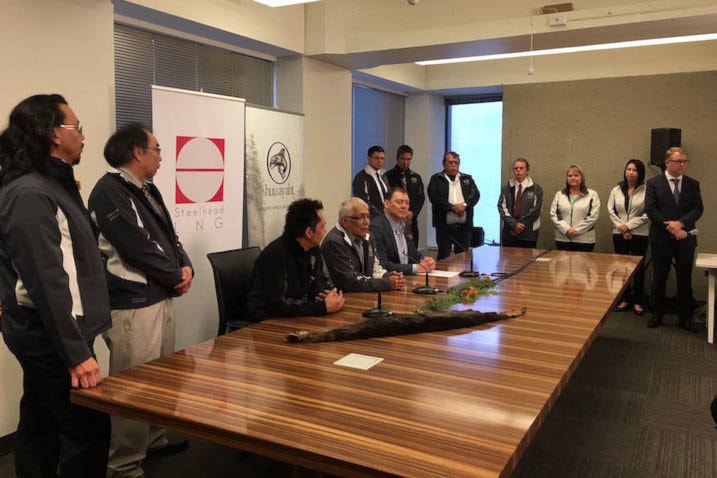Huu-ay-aht First Nations made history on Saturday, approving by referendum Steelhead LNG’s proposed liquid natural gas export facility on their traditional territory at Sarita Bay.
The vote is the earliest point in a project development that a BC First Nations community has voted to approve an LNG facility or pipeline project. Sevent percent of voters supported the project, which also received unanimous support of Huu-ay-aht’s Hawiih Council (hereditary chiefs) and elected executive council.
Huu-ay-aht Taii Hawiih (head hereditary chief) Derek Peters emphasized during a press conference on Monday that the relationship between Steelhead and Huu-ay-aht has been a positive one. “It was important that going through this project and building this relationship that our cultures, traditions, our sacred sites and the land and the environment were definitely a part of that conversation, and our chiefs were not willing to have any of these conversations if this was not included,” he said. “That’s part of the respect that goes along with this relationship that we’ve built.”
Huu-ay-aht is now the first British Columbia Nation to approve the co-management development of a liquefied natural gas facility.
“For us, we are, as we always have been, deeply respectful of the Huu-ay-aht First Nation values and culture and processes,” said Nigel Kuzemko, Steelhead’s CEO.
He added, “We are thrilled to be at this point, working with the Huu-ay-aht First Nation that we believe are setting precedence not only in Canada for Aboriginal relations with industry, but also globally.”
The project could be a financial game changer for the Nation of 750 people.
“The gap between us and Canadian society is still very wide,” said Huu-ay-aht elected chief councillor Robert Dennis Sr. “It’s our objective that our people will have a living wage where they can afford to live in their homeland. That is our focus. We not only want to close the gap but let us start being the benefactors of the wealth of the natural resources in Canada.”
Steelhead LNG has been working with potential partners, such as Williams Companies and Spectra Energy, but Kuzemko said there will be a thorough and detailed process of community engagement and First Nations engagement to follow through. “Our favourite route has always been to use existing rights of way, because it lessens the environmental impact of putting an pipeline across anywhere,” he added. The partnership offers a number of benefits for the Huu-ay-aht, including long-term sustainable jobs, an opportunity to compete for contracts, an equity stake in the project and a seat on the project oversight board.
“The project is capturing, in my view, the interests of the people,” summarized Dennis.
When asked if he had approached the people of Bamfield, or those concerned about industrial projects and increased ship traffic in the area, Dennis said,
“Our first approach was to first of all deal with the people of Hu-ay-aht before we went out anywhere else, so we’ve done that business. We certainly want to keep in close contact with [Bamfield] and have community engagement sessions moving forward.
Our message to them at this point is we live in this area together and certainly we have to be very aware of each other’s interests in terms of what we want our environment and our land to look like. We will be meeting with them.”
Huu-ay-aht elected councillor John Jack described this as a “landmark agreement,” adding, “It is a great example of free prior and informed consent by a First Nation on a large scale project where great value will be created not just for us and not just for the proponent.”
